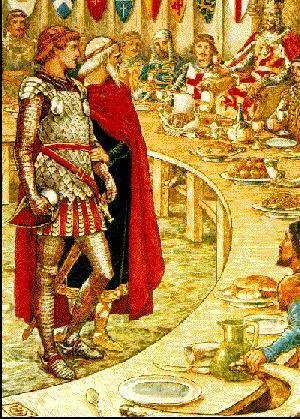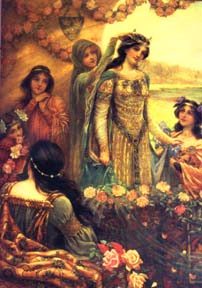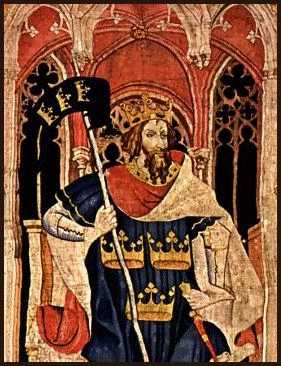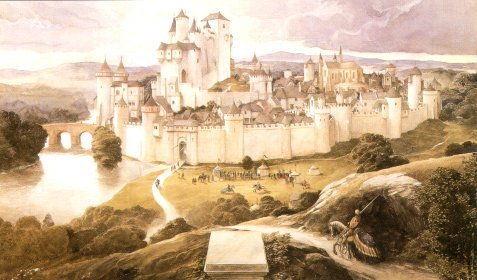

In the fourteenth century, an unknown author wrote Sir Gawain and the Green Knight, and now this poem is one thought to be of the finest Arthurian romance that belongs to the Alliterative Revival. Sir Gawain and the Green Knight is a story about many complicated issues, and mainly it concentrates on the character of Gawain who is one of the best knights in Arthur’s kingdom. The action takes place when Arthur is still young and enjoys big celebrations in Camelot. The passage from lines 60 to 129 describes the New Year’s celebration in Arthur’s court around his famous Round Table.
Celebrations at Christmas and the New Year’s holidays at Arthur’s court last for twelve continuous days. Nobility, knights and other guests gather in Camelot to enjoy music, entertainment and double portions of delicious cuisine: “This fair folk at feast two-fold was served”(line 61). Even though all plates are full, guests wait for the royal leader to arrive. Guests welcome Arthur with music, and they all sing Christmas songs: “When the king and his company were come in together. The chanting in chapel achieved and ended. Clerics and all the court acclaimed the glad season, Cried Noel anew, good news to men”(line 62). Before their meal, all guests gather to exchange gifts: “Then gallants gather gaily, hand-gifts to make, called them out clearly, claimed them by hand”(line 66). During the celebration, people exchange kisses, and the author describes some women who kiss many men: “Ladies laughed aloud, though losers they were” (line 69). Then all the visitors wash their hands before the meal, which may give us important information about social practices at the fourteenth-century English court: “When they had washed them worthily, they went to their seats”(line 72). Arrangement of seats is precisely defined and the most powerful persons sit at the head of the table.

The queen Guenevere, Arthur’s wife, sits at the top of the marvelous and richly decorated platform: “On a dais well-decked and duly arrayed with costly silk curtains, a canopy over, of Toulouse and Turkestan tapestries rich, all broiled and bordered with the best gems even brought into Britain, with bright pennies to pay” (line 75). The queen is very elegant, gorgeous and is described as perfect. The author describes Guenevere as a ideal queen: “Fair queen, without a flaw, she glanced with eyes of grey. A seemlier that once he saw, in truth, no man could say” (line 81). In other Arthurian stories, we find out that the queen pretends to be ideal, but actually, she hides her weaknesses and faults.

Next, the
author describes Arthur’s true nature. At first, he waits for his guests
to be served before he eats: “But Arthur would not eat till all were served”
(line 85). In reality, the king is waiting to be entertained, and he will
not eat until he hears a story: “For he nobly had willed, he would never
eat. On so high a holiday, till he had heard fist. Of some fair feat or
fray some far-borne tale” (line 91). In fact, Arthur is very immature;
he acts like a little, active boy who cries when he does not get what he
wants: “So light was his lordly heart, and a little boyish…So busy his
young blood, his brain so wild” (line 89).
The New
Year’s celebration goes on with very formal presentation, and everyone
enjoys great food: “ Then the first course comes, with clamor of trumpets,
that were bravely bedecked with bannerets bright…There dainties were dealt
out, dishes rare, choice fare to choose, on charges so many that scarce
was there space to set before the people” (line 116). The best silverware
is used for twelve different dishes for every guest, and there are plenty
of drinks: “Twelve dishes before each pair; Good beer and bright wine both”
(line 129). The celebration goes on and on, and everyone enjoys this great
party in Arthur’s court.

The celebration in Arthur’s kingdom is glorious, and everyone appreciates the hospitality of the king. Then something unexpected happens that changes the whole story. An unknown guest rides his horse into court. He is the Green Knight, and he calls for anyone to fight with him or to trade hits with an axe. There is no one but Gawain brave enough to fight with this unknown knight. After being hit with an axe, the Green Knight picks up his cut-off head from the floor and starts to talk as if nothing unusual has happened. His actions entertain the party and especially Arthur who now is ready for his meal.
In the
conclusion, the unknown author describes in detail each character and the
court. In this passage, we learn more about Gawain’s bravery and devotion to Arthur. The king does not seem to care about his bravest knight and puts him in a dangerous situation. Sir Gawain and the Green Knight is a beautiful fantasy that teaches us that it is not easy to remain honest and brave through life. Gawain has to face an enemy that turns out to be himself.
This page
is created by Kamila Stelmach
Back
to top